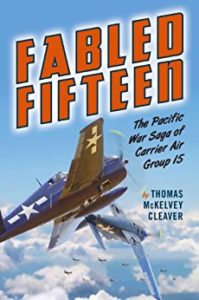 By Thomas McKelvey Cleaver, Philadelphia: Casemate Publishers, 2014
By Thomas McKelvey Cleaver, Philadelphia: Casemate Publishers, 2014
Reviewed by Jason McHale
While thousands of pilots served in the United States Navy during the Second World War, perhaps no group had as much luck at being in the right places at the right times than Carrier Air Group 15 (CAG-15). They first deployed on USS Essex (CV 9) in May 1944. When they were relieved seven months later, in November 1944, they had amassed an incredible record of achievement and fought in two of the largest naval battles of the Pacific War. The fighter squadron, Fighting 15, destroyed 312 enemy aircraft in the air and an additional 348 on the ground. The number increases by more than 300 including probable losses and damaged enemy aircraft. Twenty-six pilots became aces in the Fighting 15. Their leader, David McCampbell, was the Navy’s Ace of Aces. McCampbell finished the war with 34 kills including nine in a single mission, for which he earned the Medal of Honor.
Bombing and Torpedo 15 also shared in the collection of accolades. The two attack squadrons destroyed 174,300 tons of enemy shipping. They also played a major role in sinking the super battleship Musashi and the carrier Zuikaku, the last surviving carrier from the attack on Pearl Harbor, during the Battle of Leyte Gulf in October 1944. Every member of Torpedo 15 received the Navy Cross for actions during their tour of duty. What Carrier Air Group 15 did in those seven months of 1944 is unparalleled. Beyond their impressive kill scores, the unit took part in the two largest naval battles in history: the Battle of the Philippine Sea in June 1944 and the Battle of Leyte Gulf in October 1944. Fabled Fifteen explores CVG-15’s seven-month deployment and also looks at the man at the head of the unit, David McCampbell, and the influence he had in shaping it.
Fabled Fifteen approaches the history of the air group mostly from the pilot and cockpit perspective. The book does not try to be an authoritative history but instead places the reader in the cockpit with the pilot. The book is strongest here. The descriptions of combat, and in particular the development and ascent of David McCampbell as a leader, are engaging to read. The many personal interviews the author conducted make many of the descriptions more vivid. It’s clear the author has had a long love of naval aviation as it clearly comes through the pages.
The story of McCampbell gets thorough coverage throughout the book. His leadership development from squadron commander of VF-15 to Commander Air Group was not a smooth road, largely in part due to the universally hated new captain of Hornet, Miles Browning. Browning, an early aviator and a brilliant developer of naval aviation doctrine, was also ill-tempered and mean. These qualities endeared him to absolutely no one save perhaps Admiral William Halsey, who Browning served as Chief-of-Staff until he could be removed by offering command of the new carrier in 1943. Browning’s time as captain saw a large number of training accidents, many of which are a result of his poor leadership style and use of unsafe procedures. These incidences sent CVG-15 for further training which, in the end, provided beneficial when they were removed from the dangerous touch of Captain Browning, who later lost his command in May 1944. After further training, CVG-15 was sent to the USS Essex in April 1944 and on into the Central Pacific. During this period, McCampbell’s skills as a fighter pilot came into their own, but his capability as an air group commander was lacking. A fear of “Zero fever” overtaking McCampbell led Rear Admiral Frederick Sherman to speak with his air group commander about the importance of leading and coordinating strikes opposed to chasing zeroes. McCampbell did heed his commander’s words and his performance as CAG improved, as did his kill score. His famous record-setting mission, where he downed nine enemy planes in a single outing, occurred near the end of the Fifteenth’s tour on October 24, 1944.
Issues start to appear when the book moves away from the story of aerial combat and switches to larger operational and strategic concerns. The descriptions are not always entirely clear, with some odd attributions that do not hold up under examination. Lack of documentation furthers this problem. The bibliography is only two and a half pages long and mostly filled with secondary sources. There are no references to any official records, personal interviews, or personal papers despite being mentioned at the start of the book. This leaves the reader unsure where the information in the book comes from as there are no footnotes or endnotes. A more thorough documentation would have helped future historians in completing the history of Carrier Air Group 15.
Fabled Fifteen is a good starting point to recording the full history of the famed carrier air group. This book is a good choice for those looking to experience Pacific aerial combat through the eyes of the men that took part. Its vivid descriptions and personal anecdotes help place the reader in the cockpit. Mr. Cleaver should be applauded for preserving the stories of so many of CVG-15’s pilots. The lack of thorough documentation hurts the ability of the book to be used by scholars to continue to fill in the details of the story. It is an unfortunate oversight in an otherwise well-constructed book.
Jason McHale is an adjunct history professor at Quincy College, Edmonds Community College, Everett Community College, Renton Technical College and Southern New Hampshire University. He specializes in the Pacific Theater of the Second World War.

